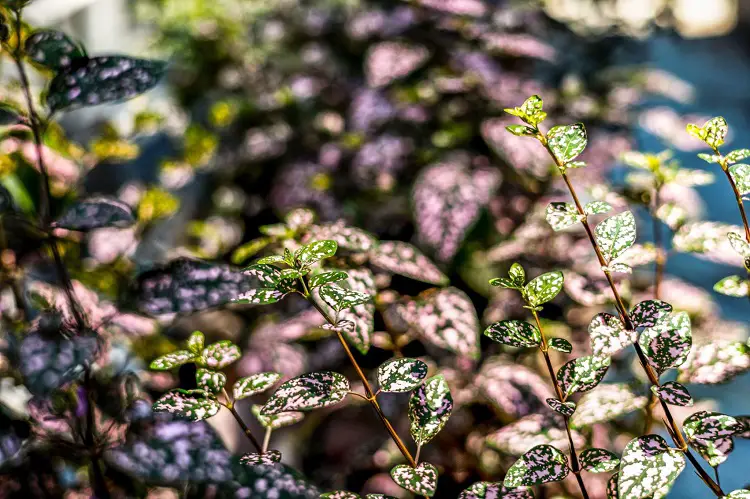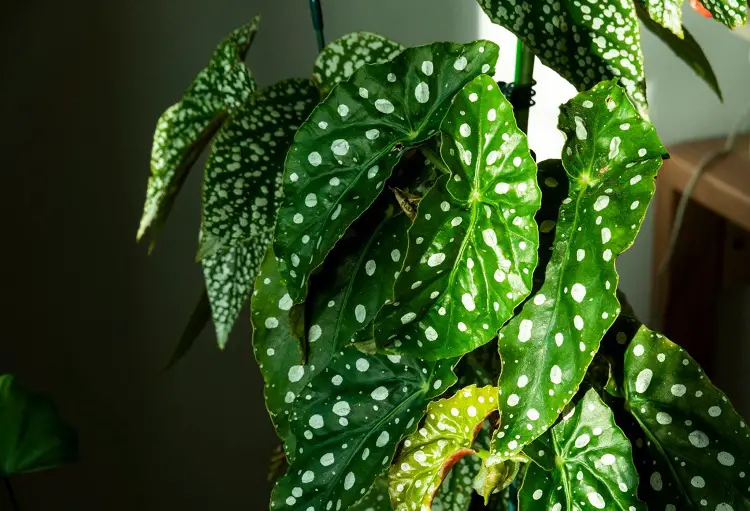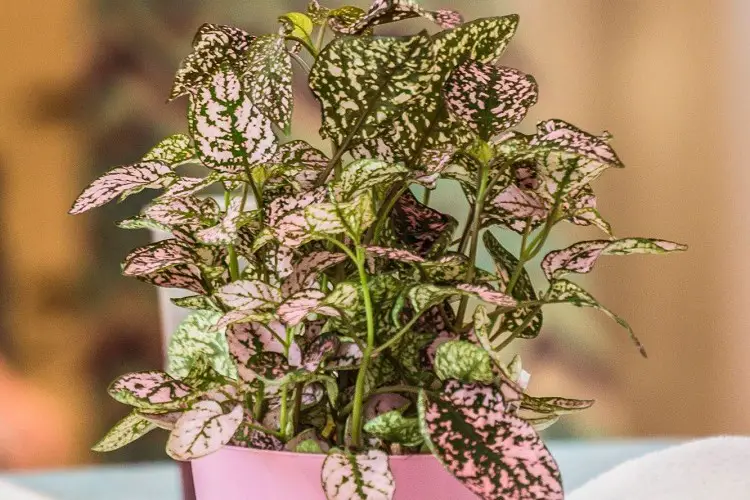The polka dot plant, whose scientific name is Hypoestes phyllostachya is a beautiful little plant. It is beautiful, and its brightly colored leaves make it unique among others.
You might be wondering how to care for polka dot plants, but the truth is that the plant is very easy to grow.
One beautiful thing about them is that they are native to warm climates and are considered annual plants by many gardeners, and the best time to plant them is in the spring.
How To Care For Polka Dot Plant

If you want to grow polka dot plants, you must be sure that you provide warm temperatures and a lot of humidity.
The polka dot plants require lots of water which you must provide to ensure their survival unless you get sufficient rainfall.
The growth and blooming of Polka dot plants are very sporadic, especially during the summer period or season.
Here is how to care for Polka Dot plant
Light
Polka Dot plants are conscious of light. It only does well when there is little light or too little light.
The next thing that will happen when planted in a place with too much light penetration or too little light penetration is that its foliage colors begin to lose their beauty.
When the foliage’s beauty is lost, the plant’s ornamental value becomes questionable, as it will no longer be attractive.
Soil
To get the best from your Polka dot plants, grow them in soil rich in organic matter and good drainage.
You can use an all-purpose organic potting mix. It will give you the best for your polka dot plant. You can also mix in some pumice or perlite to improve soil drainage.
Water Regularly
Regarding water requirements, your polka dot plant is a lover of a moderate amount of moisture in its soil at all times.
Keep the soil of your polka dot plant dry because dry soil can cause the foliage to wilt and make survival difficult for your polka dot plant.
Also, do not allow the soil to become soggy because soggy soil will also cause root rot and eventually lead to the death of the plant.
Once you notice that the top half-inch of soil has dried out, feel free to water, or your plant may struggle with survival. Also, when watering, ensure enough to moisten the soil evenly.
It is also important to slightly reduce watering activity during winter and resume your routine once growth picks up again in the spring.
Temperature and Humidity
Polka dot plants are only hardy in USDA growing zones 10 and 11 and do well with temperatures over 60 degrees F.
When caring for your polka dot plant, absolute precautionary measures must be adhered to, and they include;
Plant them outside in the spring once you are sure that the threat of frost has passed away, and then you can bring them inside during winter.
Your polka dot plant loves humid conditions, preferring a minimum humidity level of 50 percent.
If you want to raise the humidity, you can mist your plant’s leaves or place its pot on a tray filled with pebbles and water as long as the bottom of the pot isn’t touching the water.
Fertilizer
Your polka dot plant is a good consumer of nutrients hence the need to ensure that its growing soil contains organic fertilizer designed for houseplants which must be fed to the plant at least once every month during the warm growing season.
If planting in-ground, mix a layer of compost into the soil each spring.
Types of Polka Dot Plants
Within the main species, Hypoestes phyllostachya, there are wide varieties; all are bred for their leaf coloration. They include:
- ‘Carmina’: They have dark green and red-spotted leaves
- ‘Confetti’: They have green leaves with spots of white, pink, rose, red, or burgundy
- ‘Pink Brocade’: They have green leaves with mottled pink spots
- ‘Splash’ series: The leaves have mixes of greens with splotches of pinks, reds, or whites
Pruning
Your Polka dot plants have the potential to get leggy. If you want to deal with this and tackle it, you will need a pair of clean, sharp scissors or pruning shears to keep the plant in shape.
To promote a bushier growth habit, you should do this weekly, cut or pinch back the top two leaves on each stem.
Regular trimming of your polka dot plant regularly can help your polka dot plant to grow well and look very attractive.
Seeing your polka dot plant is beautiful, but it is also good to clip the flowers when they start appearing to extend the growing season.
The flowers are usually not ornamental as the leaves, and your plant may die off or enter dormancy once the flowering stage has ended.
Propagating Polka Dot Plants
You can grow polka dot plants from seeds or stem cuttings.
If you are starting from seeds, sow them in the early spring. If you are propagating from cuttings, begin your garden in the spring or summer.
You can maintain a bushier, healthier polka dot plant by trimming it, and if you live in a climate that isn’t tropical, your polka dot plant will die once the first frost hits, so stem cuttings are a great way to revive your plant indoors.
Here is how to propagate your polka dot plant from a stem cutting rooted in water or moist soil.
1. A sterilized pair of scissors or shears will be required to propagate polka dot plants using stem cuttings.
You will need water, a well-draining potting mix, or peat moss if you root them in the soil. Alternatively, you can use a rooting hormone.
2. You can cut a stem from any part of the plant, but ensure you have at least a 2-inch piece, preferably a 4-inch piece.
3. It takes about two weeks or several months for the root to grow two inches long in a jar of water, so keep the water level even by adding water as it evaporates.
Every other week, change the water to prevent bacterial or algae growth.
4. If you are rooting in the soil, place the fresh-cut end of your cutting into potting mix or peat moss and keep it moist.
Optionally, add some rooting hormone to the fresh-cut end before planting it.
5. You must cover the cutting with clear plastic wrap until the stem develops leaves or other evident growth, which can take weeks to months.
6. To determine whether the cutting has roots, gently tug on it to see if it has given or if roots hold the stem in place.
7. After the cutting has established several inches of new growth, it is ready to be repotted.
Only transplant the cutting outside once the danger of frost is eliminated.
Read Also: How To Grow Tomatoes in Pots for Beginners
How to Grow Polka Dot Plant from Seed
When sowing the seeds of your polka dot plant, you must sow them on the surface of warm, moist soil.
Also, ensure that your planted polka dot plant is sunny, and your seeds should be sprouting after a few days.
Once the seedling has grown several inches, after a couple of weeks, you can transplant it into a larger container or plant outdoors.
Potting and Repotting Polka Dot Plant
One of the signs that your plant has outgrown its pot is when the roots start growing out of the drainage holes.
If you want to repot your polka dot plant, the best time to go about it is in the spring after its dormant period.
When repotting, use a pot not more than two inches wider and no more than two inches deeper than the old pot.
Growing a Polka Dot Plant
Growing Polka Dot Plants Polka dot plants are well suited for indoor use anywhere but can also be grown annually in temperate to warm zones.
The foliage offers a pleasing foil for the brightly colored perennial flowers.
This cute plant is easy to propagate and looks great in a planter with other foliage plants, as part of a color display with flowers, or in summer borders.
In ideal conditions, freckle face plants produce small flowers and seeds germinating in soils with temperatures between 70 and 75 degrees Fahrenheit (21-27 C.).
One of the easiest ways to grow a polka dot plant is from cuttings.
Dip the cutting in the rooting hormone and plant it in a soilless growing medium such as peat moss after removing the terminal growth at a node.
Keep it evenly moist until the cutting roots, then treat it like a mature plant.
Common Issues with Polka Dot Plants To Look Out For As They Mature

Because it’s a finicky plant, you may observe signs of distress at some point in life, but you don’t have to panic if you address the issues immediately.
That’s why you should pay regular attention to the needs of your polka-dot plant.
Here are some common issues you might see as the plant matures.
Colors on leaves fade
Another issue with insufficient light is that a polka dot plant’s color may begin to fade.
Move it to a brighter location if its current location is shady or lacks natural light.
If it’s been in direct sunlight, the problem could be that it’s getting too much sun. If this is the case, relocate the plant to a less-lit location.
Leaves Turning Yellow or Dropping Off
Overwatering causes the plant’s leaves to have a yellowish color. Leaf yellowing and leaf drops are caused by wet soil.
Overwatering can cause serious problems, such as root rot and powdery mildew.
If you notice yellowing leaves, limit the water you give the plant and use potting soil with good drainage.
Brown or dry, curling leaves
Unfortunately, polka dot plant leaves go from colorful to brown without first showing signs of yellowing. Brown leaves could be caused by a variety of factors, which includes:
- Too little water
- Hard water
- Too little light
- Too much fertilizer
- Not enough humidity
- Too much direct sunlight
To figure out the problem, Start by checking the soil’s moisture level and adjusting your watering and misting schedule if it’s too dry.
For a while, try using distilled or filtered water as well. Then, assess the lighting in the room and adjust the placement of your polka dot.
If more leaves continue to brown, skip the next fertilizing session and soak the soil to remove excess fertilizer.
FAQ
Are polka dot plants easy to care for?
Polka dot plants are simple to care for and propagate. It can be difficult to get its growing conditions just right, but it’s usually fine once established.
How quickly does the polka dot plant grow?
These plants grow moderately but are picky about their growing conditions and will slow down their growth rate if they aren’t perfect.
How long does the polka dot plant live?
Polka dot plants typically have a one-year life cycle. However, you can extend their life by propagating stem cuttings at the end of the growing season.
Read Also: How to care for Amazonica plant
Conclusion
Hopefully, this article has given in-depth knowledge on how to care for Polka Dot plant. Polka dot plants are a lovely addition to any indoor space, Thanks to their vibrant foliage.
While beautiful, these plants are difficult to care for and require patience.
As long as you know how to take care of your polka dot plant and adjust your care routine based on its needs, it will flourish indoors like a champ.

